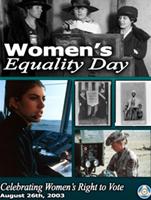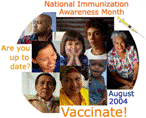
|
|
|
Cultural Link |


Topics of Interest In this IssueMinority Donor Awareness Day 8/1 Community Health Center Week 8/6—12 Women’s Equality Day 8/26 Immunization Awareness Month Children’s Eye Health & Safety Month
National Allied Health Week, 7—13
· · · · · · · National Marrow Awareness Month · National Allied Health Week, 7—13
|
|
August QUESTION “Missing women” is a concept used to examine a deficit in the number of women expected in a country’s population, a deficit that may be an indicator of lethal gender bias against women. What evidence is used to determine whether a country has “missing women”?
Email your response to nwosu@etsu.edu by 4:30 pm by August 18. The answer is found in a link in this month’s newsletter. A prize will be awarded to one winner, selected at random among those who submit the correct answer.
Answer to the June-July Question: The 1969 Stonewall Rebellion marked (B) A spontaneous riot to protest police harassment of gays and lesbians in New York City. Money extorted by police had been called “gayola.” Our June-July winner won a beautiful diversity poster.
Did You Know?¨ School-based eye exams identify many vision problems early, but studies show that minority children and those whose families do not have health insurance are least likely to receive follow-up eye care.
¨ A study of Community Health Centers, safety net health care providers, identified characteristics of frequent attendees. One surprising finding was that frequent attendees were more likely to live farther from the center than others.
¨ In August 1920, a Tennessee mother sent her son a telegram urging him to vote for suffrage. He was Representative Harry Burn who cast the decisive vote, 49—48, making Tennessee the 36th state to ratify the 19th amendment, thus giving women the right to vote in the US.(more)
|

Health Links on Diversity |
|
Article of the Month Rosenthal MS. Cultural Competency. JAMA; July 5 2006: 296 (1) 23—4. This commentary by a pediatrician and medical educator, relates her insight on cultural competence developed through her experience becoming a single mother after her husband’s untimely death. A primary goal in pediatrics is to encourage the trust of parents and influence their parenting behavior. Rosenthal notes that much pediatric advice, based on the assumptions of the traditional family model with two parents, may be impracticable for many non-traditional, single parent families. She urges her colleagues in medical education to find ways to convey the need for an empathetic approach in pediatric practice and while precepting students and residents.
assessed annually for three years. The research took an ecological approach simultaneously studying multiple individual, family, and community risk and protective factors focused on occurrence of two types of abuse: severe physical assault and assault of child self-esteem.
|
|
The listing below represents just a few of the resources available to promote knowledge, awareness and discussions on diversity in health care among ETSU students, faculty and staff.
|
TOPIC TITLE & LOCATION |
|
For more information or assistance contact Elaine Evans, Reference Assistant, COM Library,
For more information or assistance contact Elaine Evans, Reference Assistant, COM Library, evanse@etsu.edu. |
Other Observances in August |
|
August 2006 |
|
Women’s Equality Day
Health Care for Women with
UNIFEM- Initiatives by the United Nations Development
|





|
Minority Donor Awareness
|
Minorities represent more than 50% of those registered for organ transplants nationally in June 2006– Here are updated national and state transplantation data
Using Jazz to promote minority organ donation—MOTTEP of Tennessee
Asian American Donor Program— develops culturally sensitive initiatives to address the need for organ donation in a variety of Asian American populations.
Factors distinguishing donors from non-donors among Spanish dominant Hispanics– describes the descriptive variables and attitudes of those who were more likely to be organ donors.
|
|
Immunization Awareness
|
Group Targets Misinformation and Fear About Immunizations: recounts the founding of an organization after a study found that parents have several misconceptions: National Network on Immunization Information. See Do Parents Understand Immunizations? A national telephone survey for the full scientific article. Bridging disparity: a multidisciplinary approach for influenza vaccination in an American Indian community—This successful adult vaccination program in an American Indian population may offer a model for working with other groups experiencing immunization disparities. Immunization Myths about vaccines for children and Vaccine Myths about myths related to the influenza and pneumonia vaccines. Eliminate disparities in adult and child immunization rates– the goal is to reach Health People 2010 immunization targets through pubic and provider awareness campaigns, improved service delivery and assessing barriers to immunization delivery.
|
|
Community Health Centers
|
Differential access to quality rural healthcare: professional and policy challenges— Evaluation of the characteristics of counties with most and least health care resources. SW Virginia used as a case study of a unique program to fill gaps in access to care. Characteristics of Frequent Attenders At a Community Health Center– the descriptions of high utilizers of a community health center can be used to apply a chronic care model and to determine most efficient use of provider resources. Nationwide survey of dentist recruitment and salaries in community health centers– recruitment of dentists into Community Health Centers, an important safety-net provider for racial and ethnic minorities and other underserved populations. |
|
Children’s Eye Health & Safety
|
Minority & uninsured children far less likely to get eye exams or glasses– four studies document eye health disparities. Children’s Vision Information Network: Vision Development, Vision and Learning, Symptoms Checklist; link between vision and learning to read. Monocular occlusion can improve binocular control and reading in dyslexics. Experimental study of a treatment for dyslexics with demonstrated impairment of binocular fixation.
|
|
International Clown Week 1—7
World Breast Feeding Week 1—7
Hiroshima Day 6 Remembrance of the first atomic bombs dropped on Hiroshima and Nagasaki, and commitment against any further use of nuclear weapons.
Obon (Japan) Chung Yuan Festival (China, Taiwan) 9 Festival of Lanterns when the ancestors are remembered and people use lanterns to guide the spirits of the dead back to their world.
|
Caribana (Canada) 5 Festival commemorating Canda’s diverse Caribbean population
Vu Lan (Vietnam) food and offerings are prepared for the deceased wandering souls who do not have families
International Youth Day (UN) 12 2006 Theme: Tackling Poverty Together
Chu’sok Day (Korea) 15
|
|
Arts, Cultural and Health Awareness Activities |
||
|
Omoja Johnson City Unity Festival with joint ETSU/Omoja Storytelling Festival-Institute |
8/4—6 |
Freedom Hall Civic Center and Science Hill 8—9 Campus off Liberty Bell Blvd. |
|
8/8 |
Culp, E Tennessee Room |
|
|
8/16 |
WRC Pan-Hellenic Hall, Basement |
|